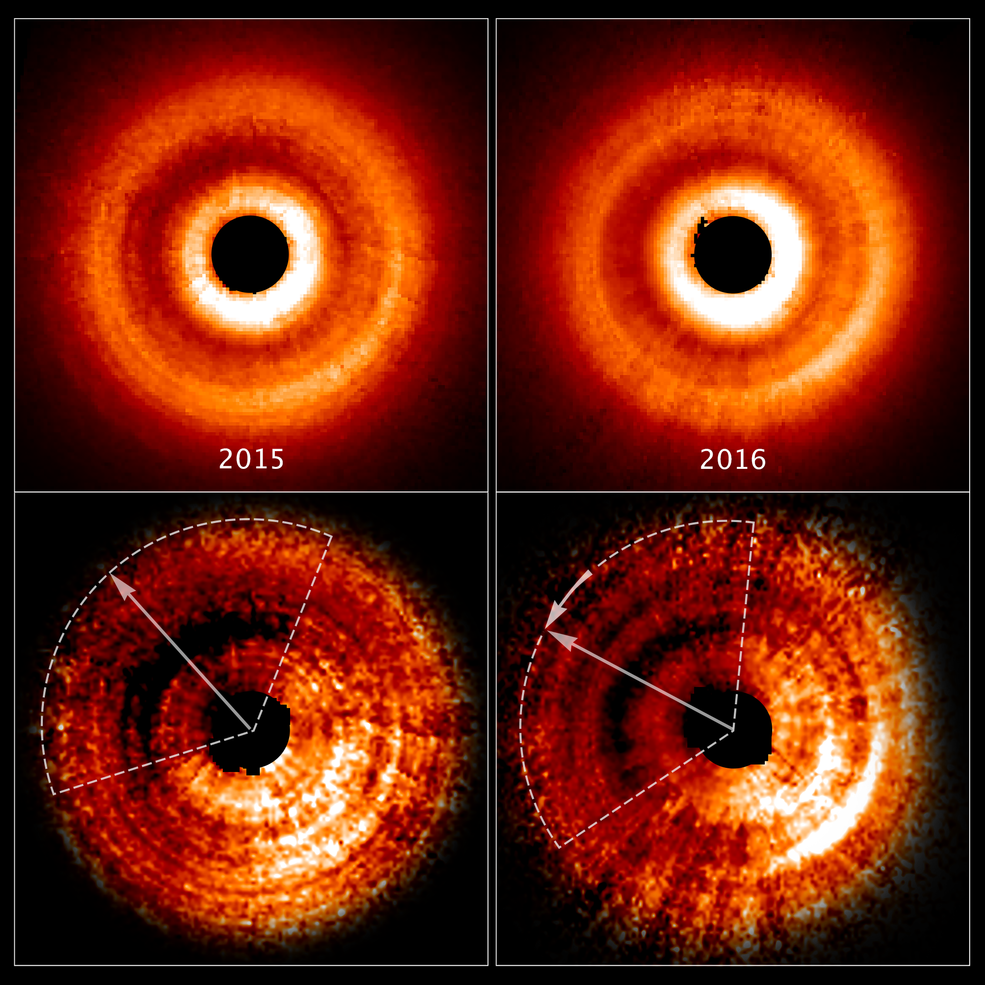
These images, taken a year apart by NASA’s Hubble Space Telescope, reveal a shadow moving counterclockwise around a gas-and-dust disk encircling the young star TW Hydrae. The two images at the top, taken by the Space Telescope Imaging Spectrograph, show an uneven brightness across the disk. Through enhanced image processing (images at bottom), the darkening becomes even more apparent. These enhanced images allowed astronomers to determine the reason for the changes in brightness. Credits: NASA, ESA, and J. Debes (STScI)
The mysterious ‘shadow play’ captured by the Hubble Space Telescope in each of the last two years has been identified by NASA.
The vast pancake-shaped gas-and-dust disk surrounding a young star, which was captured by the Hubble telescope, is now believed to be caused by gravity pulling on material near the star and warping the inner part of the disk.
NASA has concluded that an unseen planet itself is not casting the shadow, but rather the twisted, misaligned inner disk is casting the shadow across the surface of the outer disk.
The team of astronomers, which was led by John Debes of the Space Telescope Science Institute in Baltimore, examined 18 years of archival observations and said this scenario is the most likely explanation for the shadow.
“This is the very first disk where we have so many images over such a long period of time, therefore allowing us to see this interesting effect,” Debes said in a statement. “That gives us hope that this shadow phenomenon may be fairly common in young stellar systems.”
The images show a shadow moving counterclockwise around a gas-and-dust disk encircling the young TW Hydrae star. The star is approximately 80 percent the mass of and 111 percent the radius of the sun, and is 192 light-years away in the constellation Hydra, which is known as the Female Water Snake.
The shadow moved about 20 degrees between 2015 and 2016. Based on archived data, astronomers have determined that the shadow will complete a rotation around the central star every 16 years.
NASA astronomers concluded that it is a shadow because dust and gas in the disk do not orbit the star nearly that quickly. That also means that the feature must not be part of the physical disk and is likely caused by the gravitational effect of an unseen planet roughly the size of Jupiter orbiting approximately 100 million miles close to the star.
The planet creates a warped inner disk by pulling up material from the main disk, and that twisted disk blocks light from the star and casts a shadow onto the disk’s outer region, according to Debes.
“The fact that I saw the same motion over 10 billion miles from the star was pretty significant and told me that I was seeing something that was imprinted on the outer disk rather than something that was happening directly in the disk itself,” Debes said. “The best explanation is that the feature is a shadow moving across the surface of the disk.”
According to Debes, whatever was making the shadow must be deep inside the 41-billion-mile-wide disk, so close to the star that it cannot be imaged by a telescope.
The images taken by the Hubble show an uneven brightness across the disk and through enhanced image processing, the darkening becomes even more apparent.
The dimmer areas are caused by a shadow spreading across the outer disk.
The Atacama Large Millimeter Array (ALMA) in Chile suggested a possible warp in the inner disk created the shadow.
The Hubble Space Telescope is a project of international cooperation between NASA and the European Space Agency. NASA’s Goddard Space Flight Center in Greenbelt, Maryland, manages the telescope. The Space Telescope Science Institute (STScI) in Baltimore conducts Hubble science operations. STScI is operated for NASA by the Association of Universities for Research in Astronomy in Washington, D.C.




